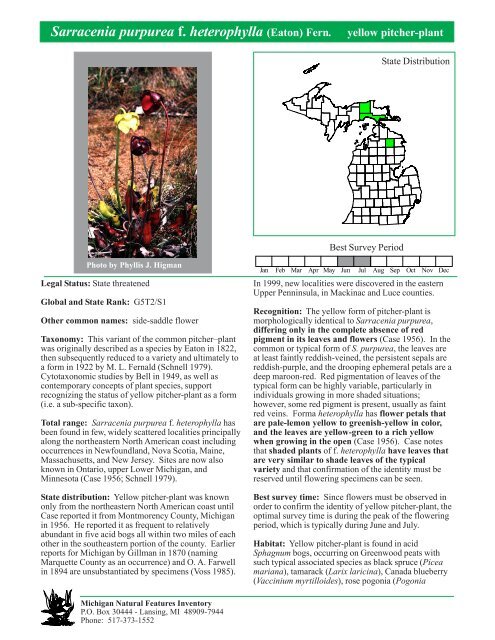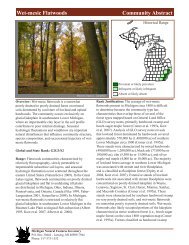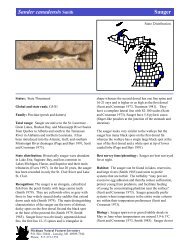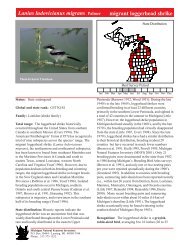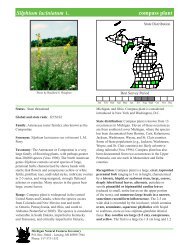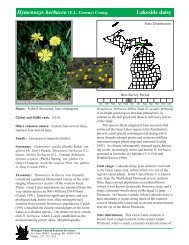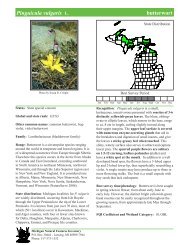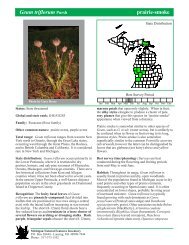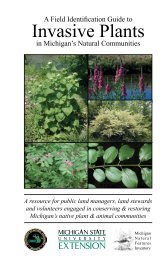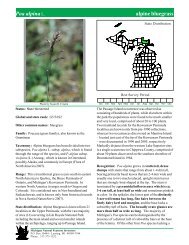Sarracenia purpurea - yellow pitcher-plant - Michigan Natural ...
Sarracenia purpurea - yellow pitcher-plant - Michigan Natural ...
Sarracenia purpurea - yellow pitcher-plant - Michigan Natural ...
You also want an ePaper? Increase the reach of your titles
YUMPU automatically turns print PDFs into web optimized ePapers that Google loves.
<strong>Sarracenia</strong> <strong>purpurea</strong> f. heterophylla (Eaton) Fern. <strong>yellow</strong> <strong>pitcher</strong>-<strong>plant</strong><br />
Photo by Phyllis J. Higman<br />
Legal Status: State threatened<br />
Global and State Rank: G5T2/S1<br />
Other common names: side-saddle flower<br />
Taxonomy: This variant of the common <strong>pitcher</strong>–<strong>plant</strong><br />
was originally described as a species by Eaton in 1822,<br />
then subsequently reduced to a variety and ultimately to<br />
a form in 1922 by M. L. Fernald (Schnell 1979).<br />
Cytotaxonomic studies by Bell in 1949, as well as<br />
contemporary concepts of <strong>plant</strong> species, support<br />
recognizing the status of <strong>yellow</strong> <strong>pitcher</strong>-<strong>plant</strong> as a form<br />
(i.e. a sub-specific taxon).<br />
Total range: <strong>Sarracenia</strong> <strong>purpurea</strong> f. heterophylla has<br />
been found in few, widely scattered localities principally<br />
along the northeastern North American coast including<br />
occurrences in Newfoundland, Nova Scotia, Maine,<br />
Massachusetts, and New Jersey. Sites are now also<br />
known in Ontario, upper Lower <strong>Michigan</strong>, and<br />
Minnesota (Case 1956; Schnell 1979).<br />
State distribution: Yellow <strong>pitcher</strong>-<strong>plant</strong> was known<br />
only from the northeastern North American coast until<br />
Case reported it from Montmorency County, <strong>Michigan</strong><br />
in 1956. He reported it as frequent to relatively<br />
abundant in five acid bogs all within two miles of each<br />
other in the southeastern portion of the county. Earlier<br />
reports for <strong>Michigan</strong> by Gillman in 1870 (naming<br />
Marquette County as an occurrence) and O. A. Farwell<br />
in 1894 are unsubstantiated by specimens (Voss 1985).<br />
<strong>Michigan</strong> <strong>Natural</strong> Features Inventory<br />
P.O. Box 30444 - Lansing, MI 48909-7944<br />
Phone: 517-373-1552<br />
Best Survey Period<br />
State Distribution<br />
Jan Feb Mar Apr May Jun Jul Aug Sep Oct Nov Dec<br />
In 1999, new localities were discovered in the eastern<br />
Upper Penninsula, in Mackinac and Luce counties.<br />
Recognition: The <strong>yellow</strong> form of <strong>pitcher</strong>-<strong>plant</strong> is<br />
morphologically identical to <strong>Sarracenia</strong> <strong>purpurea</strong>,<br />
differing only in the complete absence of red<br />
pigment in its leaves and flowers (Case 1956). In the<br />
common or typical form of S. <strong>purpurea</strong>, the leaves are<br />
at least faintly reddish-veined, the persistent sepals are<br />
reddish-purple, and the drooping ephemeral petals are a<br />
deep maroon-red. Red pigmentation of leaves of the<br />
typical form can be highly variable, particularly in<br />
individuals growing in more shaded situations;<br />
however, some red pigment is present, usually as faint<br />
red veins. Forma heterophylla has flower petals that<br />
are pale-lemon <strong>yellow</strong> to greenish-<strong>yellow</strong> in color,<br />
and the leaves are <strong>yellow</strong>-green to a rich <strong>yellow</strong><br />
when growing in the open (Case 1956). Case notes<br />
that shaded <strong>plant</strong>s of f. heterophylla have leaves that<br />
are very similar to shade leaves of the typical<br />
variety and that confirmation of the identity must be<br />
reserved until flowering specimens can be seen.<br />
Best survey time: Since flowers must be observed in<br />
order to confirm the identity of <strong>yellow</strong> <strong>pitcher</strong>-<strong>plant</strong>, the<br />
optimal survey time is during the peak of the flowering<br />
period, which is typically during June and July.<br />
Habitat: Yellow <strong>pitcher</strong>-<strong>plant</strong> is found in acid<br />
Sphagnum bogs, occurring on Greenwood peats with<br />
such typical associated species as black spruce (Picea<br />
mariana), tamarack (Larix laricina), Canada blueberry<br />
(Vaccinium myrtilloides), rose pogonia (Pogonia
ophioglossoides), grass-pink (Calopogon tuberosus),<br />
leatherleaf (Chamaedaphne calyculata), Labrador-tea<br />
(Ledum groenlandicum), bog laurel (Kalmia polifolia),<br />
sundews (Drosera spp.), Vaccinum oxycoccos<br />
(cranberry), several Sphagnum species, and other typical<br />
bog species.<br />
Biology: Pitcher-<strong>plant</strong>s have many complex<br />
interactions with insects. As a carnivorous <strong>plant</strong>, <strong>yellow</strong><br />
<strong>pitcher</strong>-<strong>plant</strong> obtains supplemental nutrients through the<br />
entrapment of insects and other small invertebrates in its<br />
<strong>pitcher</strong>-like leaves. One insect, Wyeomyia smithii Cog.,<br />
a non-biting mosquito, has aquatic larvae that are<br />
obligate inhabitants of the leaves (Istock 1975).<br />
Pollination is carried out primarily by Halictid bees and<br />
to a much lesser extent by bumblebees (Apidae) (O’Neil<br />
1983).<br />
Conservation/Management: Management for<br />
sustainable populations of <strong>yellow</strong> <strong>pitcher</strong>-<strong>plant</strong> in<br />
<strong>Michigan</strong> will require aggressive protection of the<br />
habitat conditions in which this species thrives, as well<br />
as pro-active efforts to discourage overzealous <strong>plant</strong><br />
collectors from gathering specimens. The unique<br />
physical parameters of acid bogs, i.e., the acidity,<br />
hydrology, and nutrient status are most certainly critical<br />
to the persistence of healthy populations of <strong>yellow</strong><br />
<strong>pitcher</strong>-<strong>plant</strong>. Activities that would alter these in any<br />
substantial way should be avoided. This would include<br />
direct alteration of the habitat as well as disturbances<br />
resulting from adjacent land-use activities such as<br />
extensive clearing of forested lands or nutrient loading<br />
resulting from adjacent agricultural practices. The<br />
placement of gas and oil pipelines is also a current threat<br />
to the relatively small kettle-hole bogs that support<br />
<strong>yellow</strong> <strong>pitcher</strong>-<strong>plant</strong>, and without careful routing, these<br />
habitats may be degraded.<br />
Comments: Hybrids between the typical form of<br />
<strong>pitcher</strong>-<strong>plant</strong> and f. heterophylla reportedly occur<br />
(Schnell 1979), exhibiting an intermediate orange-red<br />
coloration (Case 1956).<br />
Research Needs: Given the recent findings of two new<br />
populations of <strong>yellow</strong> <strong>pitcher</strong>-<strong>plant</strong>, surveys for<br />
additional occurrences of the <strong>yellow</strong> <strong>pitcher</strong>-<strong>plant</strong> are<br />
warranted, especially in the Upper Peninsula. Also of<br />
interest is the study of mechanisms that result in the lack<br />
of red pigmentation. The observation of <strong>pitcher</strong>-<strong>plant</strong>s<br />
with additional unusual leaf coloration, found only in<br />
locations where both the typical and <strong>yellow</strong> form were<br />
growing, led Case (1956) to believe that it is not simply<br />
the result of the expression of recessive alleles. Other<br />
research needs include virtually any aspect of life history<br />
and ecology. Conducting a long-term biological<br />
<strong>Michigan</strong> <strong>Natural</strong> Features Inventory<br />
P.O. Box 30444 - Lansing, MI 48909-7944<br />
Phone: 517-373-1552<br />
monitoring program of a selected population or two<br />
would provide useful demographic information, as well<br />
as help determine the status of this species on a yearly<br />
basis.<br />
Selected references:<br />
Bell, C. R. 1949. A Cytotaxonomic study of the<br />
<strong>Sarracenia</strong>ceae of North America. J. Elisha Mitchell<br />
Sci. Soc. 65:137-166.<br />
Case, F. W. Jr. 1956. Some <strong>Michigan</strong> records for<br />
<strong>Sarracenia</strong> <strong>purpurea</strong> forma heterophylla. Rhodora<br />
58:203-207.<br />
Istock, C.A., S.E. Wasserman and H. Zimmer. 1975.<br />
Ecology and evolution of the <strong>pitcher</strong>-<strong>plant</strong> mosquito:<br />
I. Population dynamics and laboratory response to<br />
food and population density. Evolution 29:296-312.<br />
O’Neil, W. 1983. A preliminary report on the<br />
pollination of a <strong>Sarracenia</strong> <strong>purpurea</strong> in a forestswale<br />
ecotone. Carnivorous Plant Newsletter Vol.<br />
12.<br />
Schnell, E. E. 1979. A critical review of published<br />
variants of <strong>Sarracenia</strong> <strong>purpurea</strong> L. Castanea 44:47-<br />
59.<br />
Abstract citation:<br />
Penskar, M.R. and P.J. Higman. 2000. Special <strong>plant</strong><br />
abstract for <strong>Sarracenia</strong> <strong>purpurea</strong> f.heterophylla<br />
(<strong>yellow</strong> <strong>pitcher</strong>-<strong>plant</strong>). <strong>Michigan</strong> <strong>Natural</strong> Features<br />
Inventory, Lansing, MI 2 pp.<br />
Updated September 2000.<br />
<strong>yellow</strong> <strong>pitcher</strong>-<strong>plant</strong>, Page 2<br />
Copyright 2004 <strong>Michigan</strong> State University Board of Trustees.<br />
<strong>Michigan</strong> State University Extension is an affirmative-action,<br />
equal-opportunity organization.<br />
Funding for abstract provided by <strong>Michigan</strong> Department of<br />
<strong>Natural</strong> Resources-Forest Management Division and<br />
Wildlife Division.


